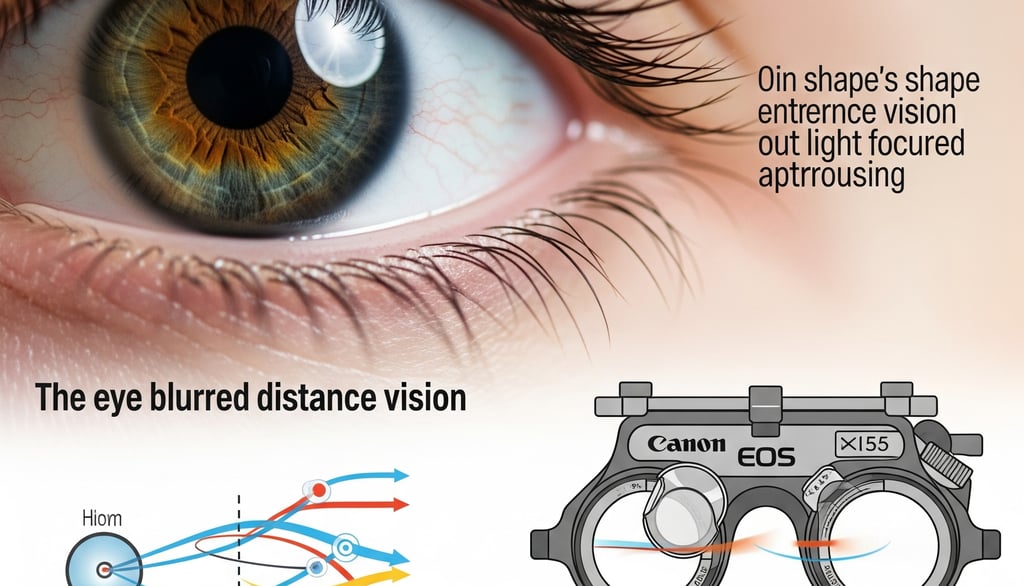What is myopia? Classification of myopia
2/1/20257 min read


Introduction to Myopia
Myopia, commonly referred to as nearsightedness, is a prevalent refractive error that affects millions of individuals worldwide. This condition is characterized by the inability to focus on distant objects clearly while nearby objects remain in sharp focus. The underlying mechanism involves the eye's shape and the cornea's curvature. In myopia, the eyeball tends to be longer than normal or the cornea is excessively curved, resulting in the light entering the eye being focused in front of the retina, rather than directly on it.
Statistics reveal a significant global impact of myopia on visual health. Recent studies have shown that the prevalence of myopia is increasing, especially among children and young adults. For instance, it is estimated that nearly 30% of the global population is affected by myopia, a figure that is projected to rise significantly in the coming decades. In urban settings, this percentage can be even higher, with rates reaching up to 80-90% in certain populations. Such growth in myopia prevalence highlights the urgent need for awareness and intervention strategies.
Understanding the various stages and types of myopia is crucial for effective management. Myopia can be categorized into several types, including low, moderate, and high myopia, each varying in severity. High myopia, in particular, can lead to more serious complications such as retinal detachment and glaucoma, necessitating regular monitoring and comprehensive eye care. This introduction serves as a foundation for understanding myopia's complexities and ramifications on visual health, and it underscores the importance of early detection and corrective measures to preserve sight.
What Causes Myopia?
Myopia, commonly referred to as nearsightedness, arises from a complex interplay of genetic and environmental factors. The biological underpinnings of myopia include hereditary influences; research indicates that individuals with a family history of myopia are more susceptible to developing this refractive error. Variations in specific genes associated with eye development have been implicated, highlighting the significant role genetics play in predisposing individuals to myopia. Studies suggest that the presence of myopia among parents can increase the likelihood that their children will also experience this condition.
In addition to genetic factors, environmental aspects significantly contribute to the development and progression of myopia. Lifestyle choices, particularly those that incorporate excessive screen time and insufficient outdoor activity, have emerged as critical risk factors. Prolonged use of digital devices often results in extended periods of near vision, which can strain the eyes and potentially alter ocular structure over time. This strain is thought to cause changes in the eye's shape, leading to light focusing incorrectly on the retina, hence resulting in nearsightedness.
The anatomy of the eye further impacts the likelihood of developing myopia. Lengthening of the eyeball, which can occur during childhood and adolescence, is a common anatomical change associated with nearsightedness. This elongation leads to light rays converging in front of the retina rather than directly on its surface. Moreover, the cornea, which is the eye's outermost layer, must also be considered; its curvature can affect how light is refracted in relation to the retina. In summary, the causes of myopia are multi-faceted, involving genetic predispositions, lifestyle habits, and particular eye anatomical structures. Understanding these factors can help in addressing and potentially mitigating the risk of myopia development.
Symptoms and Diagnosis of Myopia
Myopia, commonly referred to as nearsightedness, presents a range of symptoms that can significantly impact an individual’s daily life. The primary symptom experienced by those with myopia is difficulty in seeing distant objects clearly, which becomes increasingly noticeable over time. Activities such as driving, watching movies, or participating in sports can be hindered by blurred vision at a distance, leading to challenges in performing routine tasks.
In addition to issues with distance vision, individuals may suffer from eye strain, particularly after extended periods of reading or using screens. This discomfort often manifests as fatigue or a feeling of heaviness in the eyes. Some may also experience frequent headaches, especially after strenuous visual tasks. These symptoms highlight the necessity of early detection and intervention.
To diagnose myopia, eye care professionals employ a comprehensive eye examination. This process typically begins with a thorough patient history, followed by various tests aimed at assessing vision acuity. A primary tool used in diagnosing myopia is the Snellen chart, which measures how well a person can identify letters or symbols from a distance. Additionally, an assessment of refractive error is performed using a phoropter, allowing the practitioner to determine the appropriate corrective measures.
Another critical component of the diagnostic process involves retinoscopy, where a beam of light is projected into the eye to observe how light reflects off the retina. This technique provides valuable information about the degree of refractive error and the severity of myopia. By employing these diagnostic tools, eye care professionals can not only confirm the presence of myopia but also recommend suitable corrective lenses or alternative treatments, thereby enhancing visual clarity for affected individuals.
Classification of Myopia
Myopia, commonly known as nearsightedness, manifests in various forms and can be classified based on severity and progression. The primary classifications include low myopia, moderate myopia, and high myopia, each defined by specific measurements in diopters (D).
Low myopia is characterized by a refractive error ranging from -0.25 D to -3.00 D. Individuals in this category can typically see nearby objects clearly while experiencing difficulty with distant vision. This form generally stabilizes in late adolescence or early adulthood, requiring minimal corrective lenses for optimal vision.
Moderate myopia, categorized between -3.00 D and -6.00 D, presents a more pronounced challenge with distant vision. People with moderate myopia may begin to experience symptoms at an earlier age and require stronger corrective lenses. This level of myopia can progress more significantly during periods of rapid growth or extended visual strain, particularly with extensive screen usage or reading.
High myopia, measured as greater than -6.00 D, represents the most severe level of nearsightedness. Individuals with high myopia not only face challenges with their vision but are also at an increased risk for serious ocular complications, such as retinal detachment and glaucoma. This type often necessitates comprehensive eye care and monitoring to mitigate potential vision loss.
Aside from severity, myopia can also be categorized into two main types: axial myopia and refractive myopia. Axial myopia occurs when the eyeball is longer than average, causing light to focus in front of the retina. Conversely, refractive myopia arises due to a steep cornea or excessively curved lens, leading to a similar focusing problem. Understanding these categories is crucial for tailoring effective treatment options for individuals affected by myopia.
The Impact of Myopia on Daily Life
Myopia, commonly known as nearsightedness, can significantly affect various aspects of daily life. Individuals diagnosed with this refractive error often experience challenges in activities that require distance vision, such as driving, reading road signs, or participating in sports. When uncorrected, myopia limits the visual clarity of objects at a distance, leading to potential safety concerns, especially while driving at night or in poor visibility conditions. This limitation necessitates the use of corrective lenses, which can impose additional burdens on daily routines and activities.
In academic settings, myopia can hinder students’ performance. For instance, a student may struggle to see the board clearly during lectures, impacting their ability to take notes or follow along with teaching. The need to squint or eye strain can cause fatigue, rendering the learning environment uncomfortable and less effective. Consequently, uncorrected myopia may lead to poorer academic performance, which can persist into higher education and beyond.
Moreover, myopia can affect a person's participation in sports and recreational activities. Many sports require excellent distance vision for optimal performance, and myopia can create challenges in these settings. From playing team sports to engaging in individual activities like cycling or swimming, individuals with myopia often have to manage the inconvenience of wearing glasses or contact lenses during physical exertion. While some may opt for corrective surgery as a long-term solution, others may still find that managing myopia is crucial for maintaining an active lifestyle and overall quality of life.
Overall, the impact of myopia extends beyond mere vision correction; it encompasses various daily activities and influences both academic performance and recreational enjoyment. Proper management strategies, including regular eye examinations and appropriate corrective measures, are essential to mitigate these effects and promote better visual health.
Treatment and Management Options
Myopia, commonly known as nearsightedness, affects millions worldwide and necessitates careful management to enhance vision and prevent further deterioration. The most prevalent treatment options include corrective eyewear, which typically consists of glasses and contact lenses. These options effectively focus light onto the retina, allowing individuals to see distant objects more clearly. Glasses are often preferred for their simplicity and ease of use, while contact lenses provide a more natural field of vision without frame obstruction.
In addition to traditional corrective measures, refractive surgeries, such as LASIK, have gained popularity. This surgical procedure reshapes the cornea, thereby improving the eye's ability to focus. LASIK is beneficial for many, offering long-term improvements in vision without the daily hassle of glasses or contacts. However, it is essential to consider that not everyone qualifies for this surgery, and potential risks such as dry eyes and glare need to be thoroughly discussed with an ophthalmologist.
Emerging options in myopia management include orthokeratology, which involves the use of specially designed contact lenses worn overnight to temporarily reshape the cornea. This method can effectively slow myopia progression, especially in children. Another area of interest is the development of pharmaceutical interventions. Studies suggest that certain eye drops can slow down the elongation of the eyeball and subsequently delay the worsening of myopia in children.
Each of these treatment options comes with its advantages and disadvantages. Corrective eyewear is non-invasive and widely accessible, while surgical options offer freedom from glasses but carry some associated risks. Orthokeratology and pharmaceutical interventions provide innovative approaches but may not be suitable for everyone. Ultimately, discussing these options with an eye care professional is crucial in formulating a tailored management plan that aligns with individual needs and circumstances.
Preventive Strategies and Future Outlook
Myopia, commonly known as nearsightedness, has become increasingly prevalent in recent years, necessitating the exploration of effective preventive strategies. One of the foremost measures is the adoption of lifestyle changes aimed at minimizing risk factors associated with myopia development. Encouraging outdoor activities among children has shown significant promise; studies suggest that increasing time spent in natural light may help reduce the incidence of myopia. This is hypothesized to be due to the role of bright lighting in the stimulation of eye growth regulation. Furthermore, limiting screen time is another critical preventive strategy. Given the rise in digital device usage among younger populations, maintaining a balance between screen engagement and outdoor activity is essential for eye health.
Regular eye examinations also play a crucial role in the early detection and management of myopia. Routine visual screenings help identify any changes in vision, allowing for timely interventions such as corrective lenses or specialty contact lenses designed to slow myopia progression. Parents and caregivers should prioritize these check-ups, especially as children grow and their vision evolves.
Looking toward the future, current research trends are focused on the development of innovative myopia management techniques. Advancements in pharmaceutical treatments, like atropine drops, and the design of specially engineered lenses are being extensively studied for their potential to slow down the progression of myopia in children. Furthermore, advancements in digital technologies, such as mobile applications that encourage reduced screen time and monitor visual habits, represent an exciting avenue for future development. The continuous evolution of research methodology in myopia treatment signifies a hopeful trend in vision care, promising more effective solutions to combat this growing public health concern.
